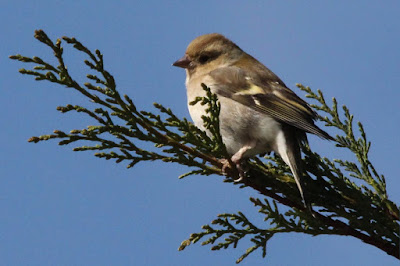 |
| Female chaffinch, Irlam Moss |
Another bad night's sleep and a debate whether to try and catch up with a nap or get some fresh air and some exercise ended up with my deciding on the latter. It was promising to become a nice day so I took the ten minute train ride to Irlam for a walk round Little Woolden Moss and back. It turned out to be a good call: it was just what I needed, the weather was excellent, the birding was good, and the biggest crowd I met was the family of four cyclists who insisted on having the entire width of Astley Road to themselves.
The hedgerows the length of Astley Road from Liverpool Road to Four Lanes End were stiff with chaffinches, goldfinches, blue tits and great tits. I spent a lot of time scanning round in the hopes of a late brambling but I think I'm going to have to wait until next Winter to strike lucky.
 |
| Chaffinches, Irlam Moss |
There wasn't a lot going on out in the fields, just the odd carrion crow or magpie, though the usual kestrel was back on its telephone wire. The field next to the motorway, one of the few not given to growing turf, was the exception with large flocks of woodpigeons and chaffinches and half a dozen stock doves. There was just the one yellowhammer, a singing male.
 |
| Female pied wagtail, Irlam Moss |
Pied wagtails and mistle thrushes joined the crows and magpies on the horse paddock fields, coinciding with an increase in the number of blackbirds in the hedgerows and field margins.
At Four Lanes End I turned onto Twelve Yards Road and headed towards Little Woolden Moss. Pairs of lapwings performed display flights in the field. A pair of buzzards soared high up and I spotted a third behind me, high up over Astley Moss.
 |
| Kestrel, Little Woolden Moss |
Little Woolden Moss was lively with lapwings, forty-odd of them calling and preening on the bunds until the buzzards started to descend and the whole flock went up. Most of them came back down a way back in the moss, the rest dispersing into the fields. Three mallards, a calling curlew and the only meadow pipits of the day added to the mix and a male kestrel kept a beady eye for anything interesting in the dead bracken.
 |
| Blackbird, Little Woolden Moss |
I could hear black-headed gulls but it was only as I was approaching the junction with the path to New Moss Lane that I could see them on the far pools.Today's plan included a wander round New Moss Wood on my way back so I joined that path, passing a group of people doing some work on the water management of the moss (the challenge being to keep it damp during a drought while avoiding its becoming a lake in wet weather).
 |
| The path to New Moss Lane |
 |
| Kestrel, Cadishead Moss |
I'd walked down New Moss Lane as far as the motorway when I spotted another pair of buzzards soaring in the distance. Four more birds, distant specks behind them caught my eye. At first I thought they were passing pigeons until they circled and soared and I realised they were yet more buzzards, probably high over Risley Moss. Further down the road a kestrel high in a tree was entirely ignored by the blackbirds and house sparrows fussing round underneath it.
 |
| New Moss Wood |
Some day I must make a point of starting a walk with a visit to New Moss Wood rather than tagging it on near the end. I found a bench, got my second wind and a late lunch of a Capri-Sun (I'd forgotten to put a packet of mints in my pocket) and had a wander. The titmice were in good voice, as was a mistle thrush singing from the treetops. I've not seen any jays this month so it was nice to see a pair of them quietly going about their business. As I rejoined New Moss Lane a couple of male pheasants made a noisy effort at flying across the fields.
Once over the railway I found a shortcut through the allotments that saved me having to walk through Cadishead onto Liverpool Road. The allotments were busy with dunnocks, robins and goldfinches and I stopped to admire a particularly spectacular bed of rhubarb. I joined Liverpool Road near the station and had barely walked two yards when a couple of sand martins flew low overhead and straight down the road towards Cadishead. Not a bad end to a good walk.

No comments:
Post a Comment